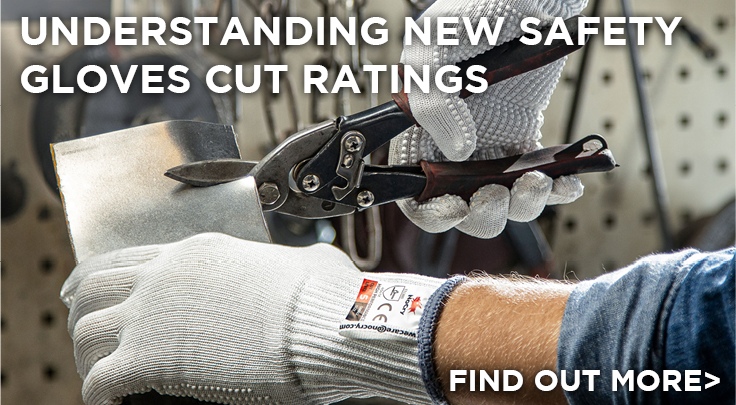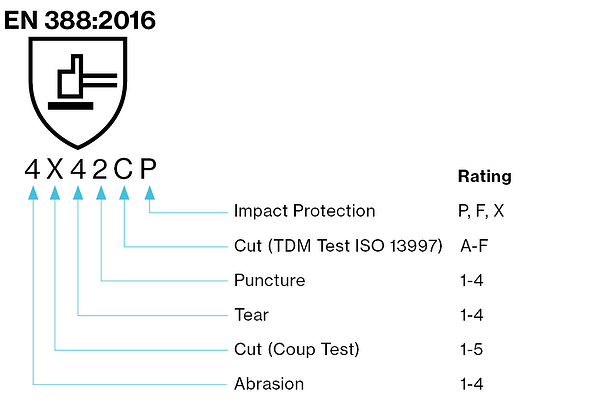
The elimination of workplace hazards is mandated by government legislation in Australia. Where hazards cannot be eliminated, employers are responsible for at least reducing them.
In order to maintain and encourage health & safety in your workplace, you need to understand the work health and safety regulations and how personal protective equipment such as safety gloves can protect workers.
The cut rating of a glove determines how resistant the gloves are. In Australia, the AS/NZS 2161 Glove Standards is used, which is replicated from the EN388 Standard.
EN388 is the European safety standard for protective gloves against mechanical risks, which has been updated several times over the years. The most recent version, EN388:2016, covers the test requirements for safety gloves that protect against mechanical risks (abrasion, blade cut, puncture, tearing and impact). EN388:2016 standard has been developed to help improve transparency around cut scores and performance so workers and safety managers can make informed decisions about the safety gloves they choose.
With the latest revision there is 2 extra digits now added to the symbol to display the performance level indicator for each risk. The higher the letter, the greater the protection level the glove has. A letter (A-F) showing the result of the various tests will be added to the right-hand side of the previous 4 digits. In addition to this, if a glove is being tested for impact protection it will achieve one of three ratings: Pass (P), Fail (F) or Not tested (X).
To comply with EN388 standard requirements, the mechanical properties of the protection gloves must be shown as the mechanical shield pictogram and printed on the packaging and on both safety gloves within a pair. So, the new performance rating is:
Position 1 - Abrasion Resistance
Position 2 - Cut Resistance (Coup Test)
Position 3 - Tear Resistance
Position 4 - Puncture Resistance
Position 5 - Cut Resistance (TDM-100 Test/EN ISO Cut Resistance Test)
Position 6 - Impact Resistance
See EN388:2016 pictogram below:

The Mechanical Risks & Stresses of Safety Gloves Test
Abrasion Resistance – Resistance to abrasion is defined by how many times the safety glove can withstand abrasive pressure from sandpaper. A glove with a low abrasive resistance may only survive 100 revolutions (level A), whereas a glove with a high abrasive resistance can withstand over 8,000 (level D).
Cut Resistance (Coup Test) – In this test, a circular rotary blade moves back and forth with a defined force (5 newtons) on the test object until the blade breaks through the material. The result is displayed as an index value calculated first from the cycle count it took to cut through the cut-resistant material and then the reference material.
Tear Resistance - The tear resistance of safety gloves is checked by having the material of the glove firstly slit. The force needed to tear the material serves as a benchmark. The tear resistance level is indicated between A and D, where D indicates the strongest material.
Puncture Resistance – The puncture resistance is defined by how much force the glove can withstand before the glove is pierced by a standard single point. The protection is also indicated by a letter between A and D, where D indicates the strongest material.
Cut Resistance (TDM-100 Test/EN ISO Cut Resistance Test) – In this test, a sliding blade and different weights are used. The TDM straight blade travels once across the material of the gloves and is only used once. The amount of force and cut length are measured and plotted to determine a trend and applied to the sample material five times to define the tolerance levels.
Impact Protection - If the safety glove has protection to impact, often referred to as ‘back of hand protection’, this information is given by the letter P as the 6th and last sign. This test is only applicable to gloves that have impact protection. If there is no “P” sign indicated, then there is no impact protection claimed.
Which Level of Safety Gloves Is Right for You?
Safety gloves are rated by cut level. But what does that really mean? And what cut level is right for your job?
Who needs the highest level of cut protection? Look for safety gloves cut 5 and/or E to F (TDM Test) if you are in industries such as:
- Heavy construction
- Rigging
- Rescue
- Mining
- Ironworking
- Any type of work that puts you at high risk for cuts and lacerations.
Who needs mid-level cut resistance? Look for safety gloves with a cut level of between 3 and 4 and/or C to D (TDM Test) if you need gloves that require good cut resistance but also a high level of dexterity, such as:
- Recycling plants
- Salvage yards
- Electrical work
- Home maintenance work
When is it safe to choose safety gloves with less cut protection? Consider safety gloves with less protection when your risk of cuts and punctures is very low, and when the injury would be very minor if a cut did occur. This includes job like:
- Glass artistry
- Catering and food industry jobs
- Some types of electrical work
- Some types of metal work
Protecting the hands in the workplace is a vital safety consideration across a wide variety of industries. Our hands can come into contact with all sorts of potentially harmful substances during everyday activities. Providing and wearing the right level of safety gloves in the workplace is important in meeting PPE (personal protective equipment) requirements across the country.
Southland Supply Group
At Southland, we have a wide range of high-quality safety gloves with varying levels of protection. Our range of work gloves are sourced from trusted brands, such as Uvex, Safetek, ATG, Prochoice, Bastion, The Glove Company, Maxisafe, Beaver and more. Our safety gloves are also available in different kinds of protective materials such as Leather, Nitrile, Kevlar, Cotton, Poly and many more, ensuring you have the right safety gloves suitable for your application. For a complete range of personal protective equipment and site safety supply, browse our wide range of products at https://www.southland.com.au/
